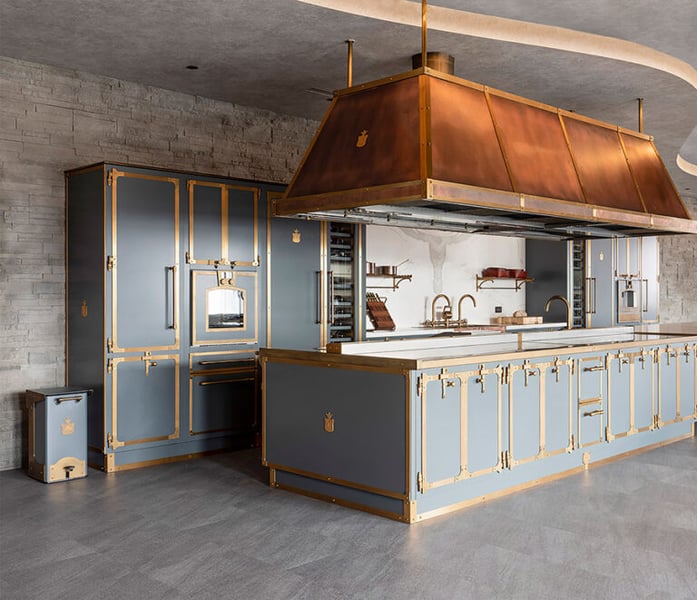Introduction
The concept of kitchen design goes beyond mere aesthetics; it delves into the intricate tapestry of habits, cultural heritage, regional influences, and national character. From the sleek and sustainable kitchens of Northern Europe to the blend of tradition and modernity in Southern Europe, each region's kitchen reflects a unique story. As we explore the diverse kitchen cultures across Europe, we uncover a fascinating world where design is not just about looks, but a reflection of the very essence of a nation's identity.
In addition to the distinct design and usage aspects of European kitchens, the choice of appliances and technological integration varies across different countries. Europeans' preferences for appliance brands, the adoption of smart appliances, and the influence of cultural values on these decisions provide further insight into the rich tapestry of European kitchen culture.
Northern European Kitchens: Embracing Modern and Sustainable Appliances
In Northern European countries, the focus on functionality extends to the choice of appliances. These kitchens tend to adopt modern, energy-efficient appliances that align with their eco-conscious values. Scandinavian households often prefer renowned brands that offer cutting-edge technologies, emphasizing sleek designs and sustainable practices.
In line with their love for nature and minimalism, Northern Europeans opt for appliances that seamlessly blend into the kitchen's overall aesthetic. Integrated appliances, such as built-in ovens, induction cooktops, and hidden dishwashers, are popular choices. These appliances not only save space but also create a clutter-free environment that promotes a sense of calm and order.
Southern European Kitchens: A Blend of Tradition and Modernity
Southern European kitchens often combine traditional charm with modern convenience. The choice of appliances is influenced by a love for cooking and culinary traditions. Families in Italy, Spain, and Greece take pride in their local cuisine, and as a result, their kitchens are equipped with high-quality appliances that facilitate the preparation of delicious, authentic meals.
While there is an appreciation for traditional cooking methods, Southern Europeans have embraced modern appliances to simplify daily cooking tasks. Iconic brands from Italy and Germany are preferred, as they offer a mix of style and functionality. Gas ranges, wood-fired ovens, and espresso machines are common fixtures, allowing residents to preserve cultural culinary heritage while embracing modernity. Italian design in particular can sit in direct contrast to the clean and minimalist aesthetic of the Scandinavian style, embracing a more colourful, flamboyant and even opulent style
Whilst standard practice in markets like the UK, not all rental properties come with fitted kitchens. The inclusion of a fitted kitchen in a rental property depends on various factors, such as the type of rental, location, and the individual agreement between the landlord and the tenant.
Furnished Apartments: Some rental properties in Italy, particularly those marketed as "furnished" or "fully equipped," may include a fitted kitchen with appliances and cabinets. These apartments are typically ready for immediate occupancy and come with essential furniture and household items, including a complete kitchen setup.
Unfurnished Apartments: On the other hand, "unfurnished" rental properties usually do not come with fitted kitchens. Tenants renting unfurnished apartments are responsible for providing their own kitchen appliances and furniture, including stoves, refrigerators, and cabinets.
Partially Furnished Apartments: Some rental properties may fall in between, offering partial furnishings. In such cases, the kitchen may have basic fixtures, such as built-in cabinets and countertops, but the appliances might not be included. Tenants may need to bring their own cooking equipment and white goods.
Read how fizzy water drink makes a huge global comeback and brings a new life for SodaStream
Eastern European Kitchens: Emphasis on Practicality and Durability
In Eastern European countries, practicality and durability take precedence when choosing appliances. Families here look for appliances that withstand heavy use and serve them well for many years. Brands with a reputation for sturdiness and reliability are highly favored.
Traditional cooking methods, such as slow cooking, remain prevalent in Eastern Europe, and some households continue to use traditional appliances like clay pots and samovars. However, as technology advances, smart appliances are slowly finding their way into these kitchens, catering to the needs of younger generations seeking convenience and efficiency.
Each country within Eastern Europe has its own unique traditions, culinary preferences, and lifestyle, which influence the way kitchens are designed and utilized.
In countries like Poland and Hungary, traditional kitchen design is still prevalent, with an emphasis on practicality and durability. Home-cooked meals are highly valued, and kitchens are equipped with essential cooking tools and appliances that withstand heavy use. Family gatherings are common, and kitchens often have spacious dining areas for communal meals.
In contrast, countries like the Czech Republic and Slovakia have seen a rise in modern kitchen designs. Urbanization and exposure to global trends have led to a demand for sleek, functional kitchens that incorporate the latest appliances and storage solutions.
In the Balkan countries, such as Serbia and Croatia, kitchens are often a blend of traditional and contemporary elements. Rustic aesthetics, traditional cooking methods, and open-fire grilling are cherished, but modern appliances and conveniences are also integrated to cater to changing lifestyles.
Western European Kitchens: Harmonizing Modern and Classic Appliances
Western European kitchens strike a balance between modernity and classic charm. The choice of appliances often reflects a blend of renowned international brands and local manufacturers. These kitchens may have a mix of stainless steel and retro-style appliances, creating an eclectic yet cohesive look.
Western Europe boasts a diverse range of kitchen designs and usage patterns, influenced by the varying cultural preferences and lifestyles of each country. The kitchen, often considered the heart of the home, holds immense significance across the region.
In France, culinary heritage plays a central role, with kitchens designed to reflect elegance and practicality. Classic French kitchens feature intricate detailing, ornate cabinetry, and luxurious finishes, emphasizing a strong connection to gastronomy and gourmet cuisine. French families value their dining traditions, and the kitchen serves as a hub for social gatherings and culinary exploration.
Germany, known for its efficiency and precision, embraces modern and functional kitchen design. German kitchens are characterized by sleek lines, handle-less cabinets, and innovative storage solutions. Practicality is paramount, with a focus on space optimization and user-friendly layouts.
The United Kingdom showcases a blend of traditional and contemporary kitchen designs. While some opt for rustic, farmhouse-style kitchens, others embrace minimalism and modernity. British households often prioritize social spaces within the kitchen, creating a welcoming environment for family and friends.
Spain, with its vibrant culture, celebrates warmth and conviviality in kitchen design. Spanish kitchens often incorporate colourful tiles, open shelving, and communal dining areas, reflecting the country's love for gatherings and fiestas.
Smart appliance adoption in Western Europe is on the rise, as families value efficiency and time-saving features. The use of smart refrigerators, ovens, and coffee machines enables users to control and monitor their appliances remotely, making meal preparation more convenient and organized.
Read how new kitchen buyers make decisions and choose appliances for a new kitchen in this case study
Conclusion
The preferences for appliance brands, the integration of smart technology, and the cultural values shaping these decisions offer a glimpse into the unique aspects of European kitchen culture. From Northern Europe's eco-conscious and minimalist approach to Southern Europe's fusion of tradition and modernity, each region's kitchen design reflects its people's lifestyles, culinary heritage, and appreciation for functionality and style. As technology continues to evolve, European kitchens are embracing smart appliances to cater to contemporary needs while holding on to their treasured cultural identities.
Read more
Read how insights can help in the process of audience understanding, new product development and the successful launch of new appliances. Learn more about the types of approaches Bryter employs in domestic appliances research.




